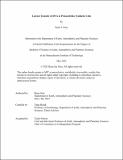Lateral Transfer of DNA in Protocell-like Synthetic Cells
Author(s)
Gray, Ryan J.
DownloadThesis PDF (5.827Mb)
Advisor
Bosak, Tanja
Terms of use
Metadata
Show full item recordAbstract
Understanding how molecules could have moved between primitive cells is a central problem in Astrobiology and Geobiology. This thesis investigates whether electroporation can mediate the transfer of DNA into and between synthetic cells, potentially enabling gene expression in initially DNA-free compartments. Both TXTL and PURE-based cell-free expression systems were encapsulated in lipid in order to evaluate fluorescence as a proxy for GFP expression following electroporation across varying voltages and pulse numbers. In TXTL-based systems, increased fluorescence in electroporated conditions relative to controls supported the feasibility of environmental DNA uptake. PURE-based systems displayed similar trends, though variability in baseline fluorescence and fold-fluorescence complicated interpretation. In experiments designed to model lateral gene transfer (LGT) between synthetic donor and acceptor vesicles, modest fold changes in GFP expression were observed, particularly after multiple electroporation rounds, suggesting limited but detectable DNA transfer between vesicles. While microscopy provided some support for internal expression, its resolution and interpretability were strongly limited. Altogether, these findings support the concept that electroporation-like events such as those generated by lightning on early earth Earth could have promoted the horizontal movement of genetic material among protocells. Additionally, this work highlights key experimental challenges in modeling prebiotic genetic exchange, while also contributing to the development of synthetic biological systems that emulate early evolutionary processes.
Date issued
2025-05Department
Massachusetts Institute of Technology. Department of Earth, Atmospheric, and Planetary SciencesPublisher
Massachusetts Institute of Technology